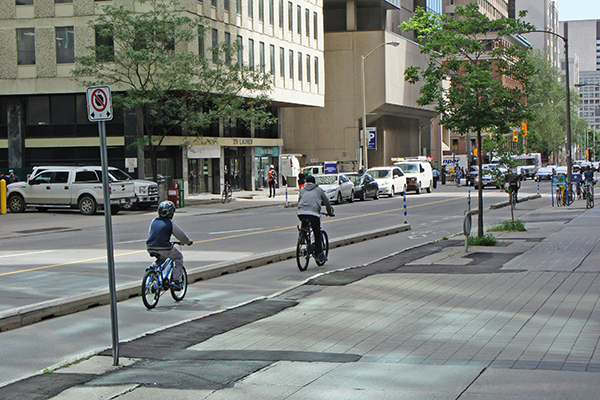Canada / Cycling infrastructure / Facilities / Infrastructure / Mobility / Mobility management / Network planning / Research
Exploring the future multimodal networks in Ottawa
The City of Ottawa is undertaking a new Official Plan, and with it an update to its Transportation Master Plan. These updates will look to adapt and expand upon existing mobility strategies to meet anticipated demand as the city continues to grow and change. As long-standing partners, the City engaged Mobycon to perform a background study focused on best practices within context sensitive multimodal network planning, identifying key principles and guidelines that will serve as references for the TMP update.

Justin Goulding led the Mobycon team to develop a reference document that identifies approaches to designing a variety of transportation networks. Particularly focus was given to adapting the network to the unique needs of different modes and mitigating conflict where competing networks intersect or overlap. The study draws upon a review of existing City policies and plans, determines gaps and conflicts and includes an in-depth review of Canadian and international best practices in network planning.
Having already identified a number of challenges experienced during the implementation of cycling facilities, there was an acknowledgement that existing policies included a wide variety of planning classifications for road types. These classifications, however, did not clearly indicate how to prioritize the various typologies when they compete for limited space. This poses a particular challenge in areas where a variety of competing interests come together.
Though the study took a truly multimodal approach, a historical under representation of walking and cycling in rigorous network planning exercises has resulted in emphasising how to more holistically reflect their needs in future plans. This took the form of guidance highlighting the need for walking and cycling networks to be more direct and convenient than the competing network for motor vehicle traffic. Focus was also placed on the relationship between the comfort of vulnerable road users and their proximity to high capacity roadways. The principles presented should help to take the advantages of each mode and draw upon them in creating a more efficient and human-centred approach to transportation.
Additionally, another core feature of this work provides a framework better linking transportation networks to their surrounding environment. As Ottawa grows there is an increasing desire to develop policies that help create streets that reflect the land use and activities around them. In order to achieve this the study identifies a limited set of “mobility environments” that indicate dominant modes, speed, and expected behaviours and surrounding activities. This framework could provide the City with a tool to undertake a proactive approach to network planning and design that better reflects adjacent activities and the public realm rather than solely focused on traffic.
Combining the background and best practice review, the resulting reference document could help the City of Ottawa simplify their road typologies in order to mitigate conflicts. Ultimately, this would enable network designs that can respond to the environmental context in which they exist and encourage a more comprehensive network planning moving forward.

